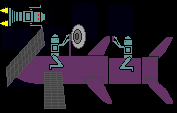
THE MARRIAGE OF ENTERTAINMENT AND SPACE EXPLORATION
Space exploration has been poorly handled, most especially in its aspect as entertainment. Going into space is not primarily an engineering project; it is an adventure. An adventure is best planned not by a government agency, but by people who know how to package adventure so that it can be widely experienced. So what would space exploration be like if it were turned over to Disney? Let's imagine.
Ticker, Bicker, and Licker have just landed on Snowball, a near-Earth comet core. They fumble around, unloading equipment and tripping over each other. Their Egos (telepresence operators) make snide comments to one another. A cartoon character accomplice, Kicker, acts as narrator to explain (using crude diagrams) what the three miniature robots are doing, and frequently tells them to get busy or he'll "kick their butts". Each robot has a distinct personality (through its operator).If the robots and their machines are small enough, the launch cost of this approach is not all that high. Since such robots have virtually no intelligence, there is no great software development effort required. Since several robots are sent, the mission can continue even if one or two are lost. Since no life is at stake, there is no need for extremely reliable systems. Since there is plenty of time, the transportation and water extraction systems can be low-power and small. These factors make it possible for companies such as Disney to go it alone, without government assistance. They also make it possible for space development to become a playful adventure.The robots have two eyes, two arms, and weigh just 10 pounds. Each is operated by someone on Earth who sees what the robot sees and whose arm motions are mimicked by the robot. The robots are designed not only for function, but for comical appearance. They use tools such as a well drilling machine which are also designed for visual interest, and have nicknames like "Brontosaurus".
The robots take several months to extract water from the comet core and perhaps a year to bring it back (by steam rocket) to geosynchronous Earth orbit. Videos of their efforts are heavily edited and parceled out so as to optimize the entertainment value. Once in orbit around Earth, they use Dandelion (a solar energy collector) to convert the water to hydrogen/oxygen rocket fuel, and using the fuel they take off in search of abandoned rocket engines and other space debris. Their adventures include repairing dead satellites using parts from other satellites, and cobbling together odd pieces of rubble to make space tugs. In time they are met by brother robots with new capabilities, and Ticker, Bicker, and Licker take off again for more water.
For another approach to using the entertainment value of space (or more specifically, the Moon), check out LunaCorp's Robots in Cyberspace . If you see any large holes in the above arguments, we would appreciate hearing about them.
